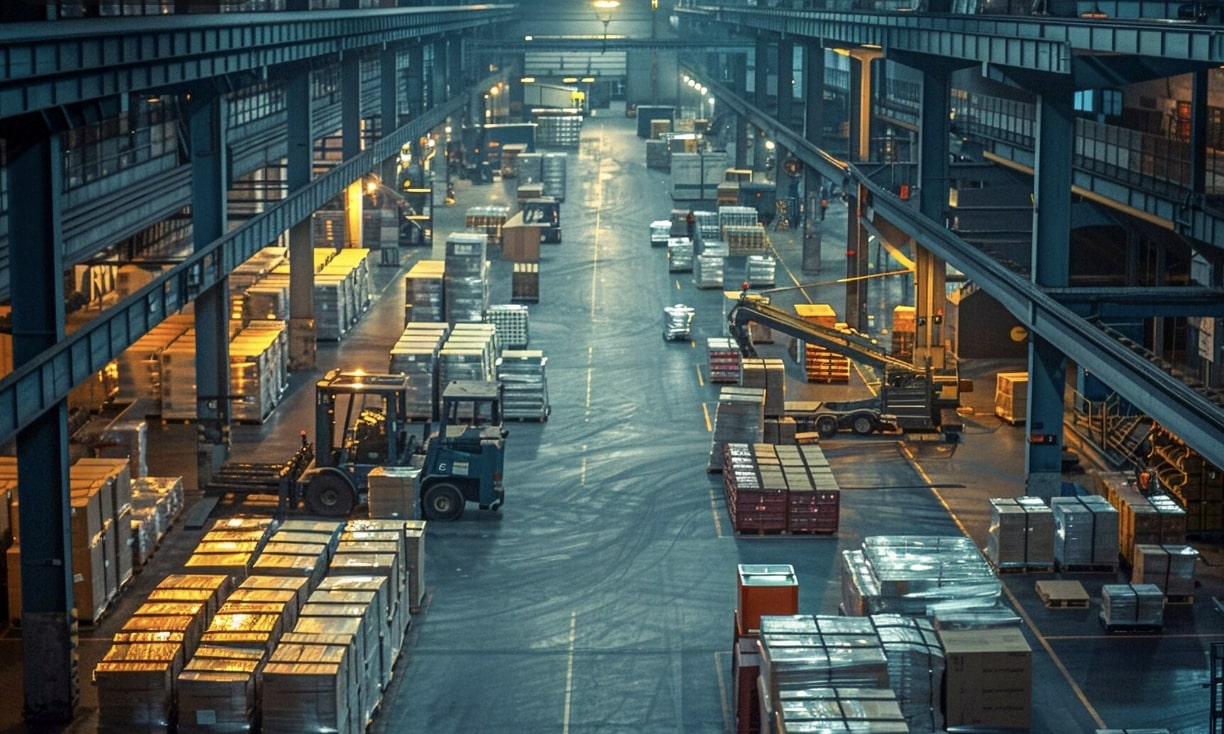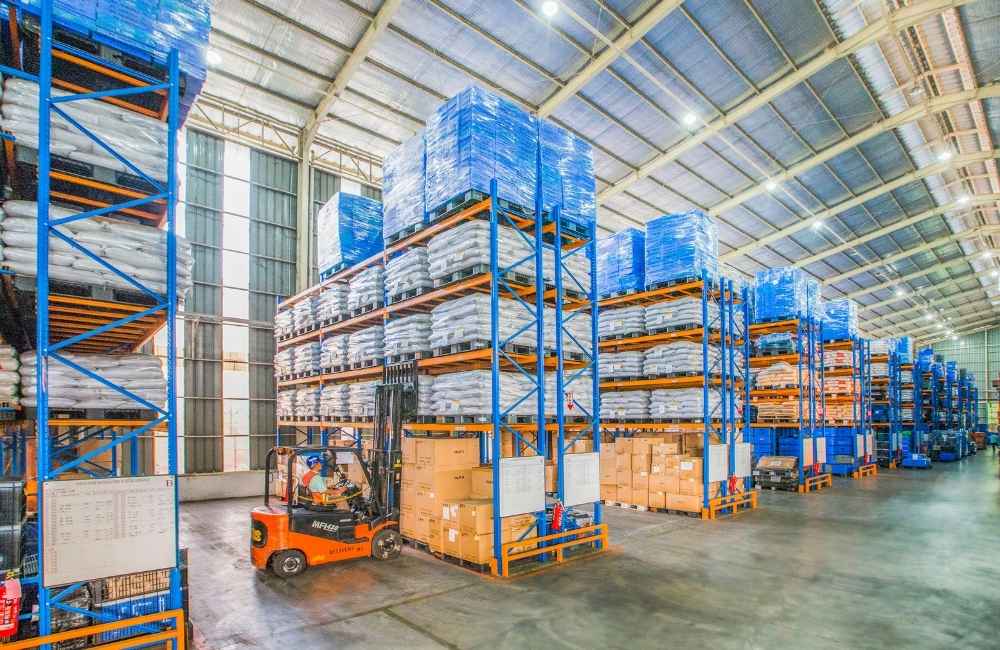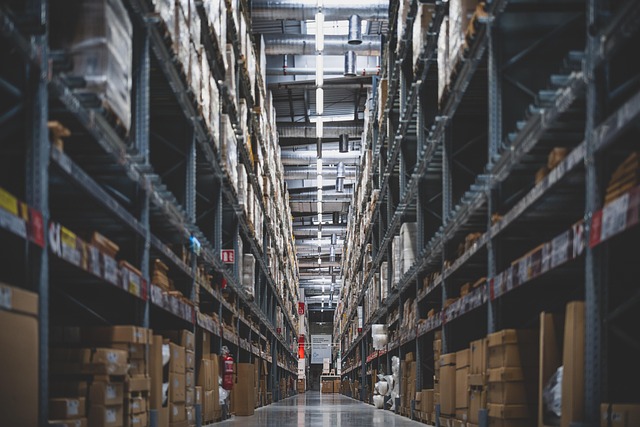Warehouses play a critical role in the movement and storage of goods across industries. Businesses rely on different types of warehouses in supply chain management to store, organize, and distribute products efficiently. Warehousing plays a vital role in supply chain management by ensuring inventory is properly stored, tracked, and readily accessible to meet customer demand. It encompasses essential functions such as inventory control, secure storage, and efficient order fulfillment.
Here are the ten essential types of warehouse facilities and how they support supply chain success.
Table of Contents
Key Takeaways
✔ Distribution centers enable fast, high-volume movement of goods with minimal storage time for quick order fulfillment.
✔ Public warehouses offer flexible, low-commitment storage solutions ideal for startups, seasonal needs, and market testing.
✔ Private warehouses provide full control and customization for large companies with stable, long-term inventory needs.
✔ Bonded warehouses allow duty-deferred storage of imported goods under customs control to ease cash flow and compliance.
✔ Smart warehouses use automation and data-driven systems to boost speed, accuracy, and scalability in operations.
✔ Consolidated warehouses combine shipments from multiple suppliers into one load to cut transportation costs and simplify delivery.
✔ Climate-controlled warehouses maintain strict temperature and humidity levels to protect sensitive or perishable products.
✔ Fulfillment centers specialize in processing, picking, packing, and shipping e-commerce orders efficiently.
✔ Cross-docking warehouses transfer goods directly from inbound to outbound shipping to reduce handling and inventory time.
✔ Hazardous materials warehouses store dangerous substances with advanced safety features and regulatory compliance protocols.

1. Distribution Centers
A distribution center is a fast-paced logistics hub focused on the efficient flow of goods rather than long-term storage. These centers streamline operations by handling high volumes of incoming and outgoing inventory with minimal dwell time. Among the most critical types of warehouses in supply chain management, distribution centers help balance demand and supply while maintaining high delivery accuracy.
Key Functions
- Receiving: Incoming goods are scanned, sorted, and prepped for redistribution.
- Sorting: Products are organized by destination, order priority, or transport method.
- Shipping: Orders are packed and dispatched quickly, often within hours.
Strategic Advantages
- High Throughput Efficiency: Automation and streamlined workflows support rapid handling of thousands of SKUs per day.
- Inventory Turnover: Fast-moving goods pass through quickly, reducing holding costs and shelf waste.
- Real-Time Data Integration: Many centers use warehouse management systems (WMS) to provide real-time tracking and performance metrics.
2. Public Warehouses
Public warehouses are flexible storage solutions operated by third-party logistics providers (3PLs). They allow businesses to rent space and services without capital investment. In the context of types of warehouse facilities, public warehouses offer unmatched flexibility, making them a popular choice for dynamic businesses.
Services Offered
- Inventory Management: Barcode scanning, stock rotation, and cycle counts.
- Value-Added Services: Labeling, repackaging, kitting, or light assembly.
- Transportation Support: Many are connected to freight forwarding or delivery services.
Ideal For
- Startups and SMEs: Businesses that can’t justify the cost of owning a warehouse.
- Seasonal Businesses: Brands that see large fluctuations in inventory due to holiday or weather-related trends.
- Market Testing: Companies entering new regions without setting up full infrastructure.
Benefits
- Cost-Effective: Pay-as-you-go models help control cash flow.
- Scalable: Quickly scale up or down based on need, without fixed overhead.
- Minimal Commitment: Use only when necessary, avoiding long-term leases or capital investment.
3. Private Warehouses
Private warehouses are owned and controlled by a single company and used exclusively for that business’s inventory and operations. These facilities are typically tailored to meet specific requirements. Among the most robust types of warehouses in supply chain management, private warehouses provide operational autonomy and long-term savings for enterprises with scale.
Typical Operators
- Retail Giants: Companies like Walmart or Target with high-volume logistics needs.
- Large Manufacturers: Firms that manage raw materials and finished goods internally.
- Vertically Integrated Brands: Businesses that oversee the entire supply chain to maximize quality and timing.
Benefits
- Customization: Layout, equipment, and technology can be designed around unique workflows.
- Security: Full control over access, procedures, and compliance measures.
- Efficiency Gains: Eliminates dependency on third parties, allowing for more accurate forecasting and faster decision-making.
Considerations
- Higher Upfront Cost: Requires capital expenditure for construction, maintenance, and staffing.
- Long-Term Use: Best suited for organizations with stable, predictable inventory needs.
4. Bonded Warehouses
Bonded warehouses are specialized storage facilities regulated by customs authorities, designed to hold imported goods until duties and taxes are paid.
Key Characteristics
- Customs-Controlled Access: Goods are stored under bond, meaning importers don’t take full possession until all fees are paid—a common setup in a distribution warehouse example handling international shipments.
- Extended Holding Periods: Items can remain in storage for months or even years without incurring penalties.
- Deferred Duty Payment: Taxes are only paid when goods leave the warehouse for domestic distribution, improving cash flow.
Use Cases
- International Traders: Useful for businesses engaged in high-volume imports who want to delay customs costs.
- Bulk Storage for Exports: Some goods may be re-exported without ever entering the domestic market, avoiding duties altogether.
- Sensitive Commodities: Ideal for storing alcohol, tobacco, luxury goods, or electronics—items often subject to high import tariffs.
Strategic Value
- Regulatory Compliance: Helps companies comply with cross-border regulations while reducing financial strain.
- Bonded Warehouses: Although the two basic types of warehouses are public and private, bonded warehouses act as a hybrid with added legal oversight.
5. Smart Warehouses
Smart warehouses use cutting-edge technologies to improve every aspect of inventory management and order fulfillment. They represent a shift from traditional manual operations to intelligent, data-driven logistics. Smart warehouses are among the most innovative types of warehouses in supply chain management, helping businesses achieve higher throughput, agility, and visibility across their logistics network.
Core Technologies
- Robotics: Automated Guided Vehicles (AGVs), robotic arms, and conveyor systems speed up movement and sorting.
- AI & Machine Learning: Predictive analytics optimize restocking and order picking.
- IoT Sensors: Track real-time location, temperature, and handling conditions of goods.
- Warehouse Management Systems (WMS): Centralized software for coordinating all warehouse functions.
Benefits
- Labor Efficiency: Reduces reliance on manual labor, lowering long-term operating costs.
- Accuracy & Speed: Minimizes human error and supports faster fulfillment cycles.
- Scalability: Systems can grow with demand without adding significant staff.
6. Consolidated Warehouses
Consolidated warehouses streamline transportation by aggregating goods from multiple sources into a single shipment, which reduces costs and simplifies last-mile logistics. Understanding that the two basic types of warehouses are public and private helps frame consolidated warehouses as a smart extension of public facilities, designed for collaboration and efficiency across supply chain partners.
Functions
- Shipment Pooling: Small shipments from different suppliers are combined into one larger load.
- Order Coordination: Inventory is held until all required items arrive, then dispatched together.
- Freight Optimization: Reduces underutilized space in transport vehicles.
Key Users
- Retailers & Distributors: To consolidate products from various suppliers before delivering to stores or fulfillment centers.
- SMBs with Shared Vendors: Small businesses benefit from lower freight charges and joint deliveries.
Operational Advantages
- Cost Savings: Fewer shipments mean reduced fuel, labor, and toll expenses.
- Sustainability Gains: Fewer trucks on the road lower the environmental footprint.
- Delivery Simplification: Fewer deliveries simplify receiving and reduce delays at the destination.
7. Climate-Controlled Warehouses
Climate-controlled warehouses are designed to store goods that are sensitive to temperature and humidity changes. These facilities play a vital role in maintaining product integrity throughout the supply chain. The climate-controlled storage market is expanding quickly, driven by the growing demand to preserve goods in environments with regulated temperature and humidity. Among the specialized types of warehouse facilities, climate-controlled warehouses are non-negotiable for sectors handling perishable or reactive inventory.
Key Features
- Temperature Regulation: Maintain consistent cold or ambient temperatures using HVAC systems, as seen in a distribution warehouse example handling perishable goods.
- Humidity Control: Prevent moisture-related damage with dehumidifiers and air quality systems.
- Insulation & Sealing: Protect interiors from external weather fluctuations and contaminants.
Product Categories Stored
- Pharmaceuticals: Many drugs lose potency or become hazardous if stored incorrectly.
- Fresh Produce & Meat: Requires strict cold chain management to prevent spoilage.
- Electronics: Sensitive to heat and moisture, which can damage circuitry.
- Cosmetics & Chemicals: Susceptible to breakdown or separation in volatile conditions.
Advantages
- Regulatory Compliance: Meets FDA, USDA, and international storage standards.
- Product Longevity: Reduces loss due to spoilage or quality degradation.
- Brand Trust: Ensures consistent quality upon delivery, improving customer satisfaction.
8. Fulfillment Centers
Fulfillment centers handle end-to-end order processing—receiving, inventory management, picking, packing, and shipping—all under one roof. These centers serve as the backbone of modern e-commerce logistics. Fulfillment centers are among the most critical types of warehouses in supply chain management, directly impacting customer satisfaction through fast and accurate delivery performance.
Operational Workflow
- Receiving Inventory: Bulk shipments from manufacturers or suppliers.
- Picking & Packing: Individual items are picked based on customer orders, then packed with efficiency.
- Shipping Integration: Orders are labeled and handed off to couriers for last-mile delivery.
Benefits
- Speed: Accelerates delivery by processing orders near end customers.
- Accuracy: Automation tools like barcode scanning reduce packing errors.
- Scalability: Can manage seasonal spikes in demand without disruption.
9. Cross-Docking Warehouses
Cross-docking warehouses are designed for speed and efficiency, allowing goods to move directly from receiving to shipping without long-term storage. Among the lean-focused types of warehouse models, cross-docking supports just-in-time delivery and minimizes overhead in fast-moving logistics environments.
How It Works
- Inbound Logistics: Trucks deliver goods to one side of the warehouse.
- Sorting & Staging: Items are quickly sorted based on destination.
- Outbound Transfer: Goods are loaded onto outbound vehicles—often within hours of arrival.
Ideal For
- Perishables: Like dairy, meat, or produce that must move quickly to preserve freshness.
- Retail Chains: Especially those with centralized distribution and frequent restocking needs.
- Time-Sensitive Shipments: Products under delivery SLAs or JIT (Just-In-Time) systems.
Advantages
- Reduced Inventory Holding: Cuts warehousing costs by minimizing storage time.
- Faster Delivery: Goods spend less time idle, improving supply chain velocity.
- Lower Labor Costs: Less handling translates to fewer man-hours and errors.
10. Hazardous Materials Warehouses
Hazardous materials warehouses are engineered to safely store substances that pose health, fire, chemical, or environmental risks. These facilities follow stringent protocols to ensure safe handling and regulatory compliance. Hazardous materials warehouses serve as a protective barrier between dangerous goods and the general public—making them a crucial part of high-stakes, safety-sensitive types of warehouses in supply chain management.
Types of Hazardous Materials Stored
- Flammable Liquids: Gasoline, solvents, or alcohol-based products.
- Toxic Chemicals: Pesticides, industrial cleaning agents, and corrosives.
- Reactive Substances: Materials that may combust, oxidize, or degrade under specific conditions.
- Compressed Gases: Propane, oxygen, or industrial gases under pressure.
Critical Safety Features
- Fireproof Construction: Use of fire-retardant materials, firewalls, and sprinkler systems.
- Spill Containment Systems: Drains, bunds, and chemical-resistant flooring to prevent leaks and contamination.
- Explosion-Proof Lighting and Equipment: Designed to avoid ignition in volatile atmospheres.
- Ventilation Systems: Maintain air quality, reduce vapor buildup, and prevent toxic exposure.
Regulatory Compliance
- OSHA and EPA Standards: Warehouses must comply with Occupational Safety and Environmental Protection Agency rules.
- Zoning Restrictions: Facilities are often located in industrial zones away from residential areas to limit exposure risk.
- Material Safety Data Sheets (MSDS): Required documentation for all stored substances.
- Certified Staff: Employees must be trained in hazardous material handling, emergency response, and use of protective gear.
- Ongoing Safety Drills: Regularly conducted to prepare for spills, fires, or chemical leaks.
Function in Supply Chains
- Specialized Hazardous Warehouses: Hazardous warehouses may not fall under the two basic types of warehouses are public and private, but they function as an indispensable specialized category.
- Critical for High-Risk Industries: Essential for industries such as oil & gas, mining, pharmaceuticals, automotive, and agrochemicals, where compliance and risk management are top priorities.
How to Choose the Right Warehouse Type
Selecting the right warehouse involves evaluating several business factors:
1. Assess Storage Requirements
Businesses should first analyze their inventory types, volume, and handling needs. If perishable goods are involved, a climate-controlled solution is necessary. For rapid distribution, a fulfillment or cross-docking center might be better.
2. Evaluate Ownership vs. Outsourcing
Understanding the two basic types of warehouses are private and public is foundational. Private warehouses offer control and customization, while public warehouses offer flexibility and cost-efficiency.
3. Consider Automation and Technology
If the goal is to streamline operations with advanced tools, smart warehouses provide solutions through robotics, sensors, and real-time analytics.
4. Review Legal and Compliance Needs
Industries dealing with hazardous materials, imported goods, or medical supplies must ensure the chosen warehouse meets regulatory standards and compliance requirements.
5. Analyze Transportation and Location
Location plays a strategic role in reducing transit times and improving responsiveness. A distribution warehouse example in a central urban location can shorten delivery times and reduce shipping costs.
6. Forecast Growth and Scalability
Scalability is essential for growing businesses. Public and consolidated warehouses can easily adjust to changing volumes, making them attractive for dynamic markets.
Frequently Asked Questions
Warehouses can be classified based on ownership, function, and the type of goods stored. The most common classifications include public warehouses, private warehouses, bonded warehouses, and cooperative warehouses. Additionally, modern categories such as smart warehouses and climate-controlled warehouses have emerged to meet specific industry needs.
In supply chain management, a warehouse is a facility used to store, manage, and distribute goods efficiently throughout the supply chain. It acts as a central hub for receiving inventory, organizing stock, and fulfilling orders. Warehouses play a critical role in balancing supply and demand, improving delivery times, and reducing operational costs.
The three main types of distribution centers are retail distribution centers, service parts distribution centers, and e-commerce fulfillment centers. Retail distribution centers handle bulk goods destined for brick-and-mortar stores. Service parts centers focus on spare parts for maintenance, while e-commerce fulfillment centers process individual online orders for direct-to-consumer delivery.
The three common types of warehouse layout are U-shaped, I-shaped (through flow), and L-shaped. A U-shaped layout combines receiving and shipping areas on the same side to streamline movement and reduce travel time. I-shaped layouts separate inbound and outbound operations on opposite ends for a continuous product flow, while L-shaped layouts are used in irregular spaces or hybrid operations.
The four types of warehouse management systems (WMS) are standalone systems, ERP-integrated systems, cloud-based systems, and supply chain modules. Standalone systems offer core WMS features but lack integration with other platforms. ERP-integrated systems combine warehousing with broader enterprise functions, cloud-based systems provide flexibility and real-time access, and supply chain modules are part of comprehensive logistics platforms.
https://warehouse-logistics-nyc.com/
Get the Right Warehouse Solution with Warehouse Logistics By Best
Choosing the right warehouse type is essential for streamlining your supply chain and improving operational efficiency. Whether you need fast-moving distribution, climate-controlled storage, or compliance-ready facilities, expert guidance can make all the difference. That’s why Warehouse Logistics By Best in New York, NY, is the trusted partner for businesses looking to optimize their logistics.
Warehouse Logistics By Best offers tailored solutions designed to meet your exact needs, no matter your industry or inventory size. Serving companies throughout New York, NY, Warehouse Logistics By Best combines local insight with national expertise.
Reach out to Warehouse Logistics By Best today and take the next step toward more efficient, scalable warehouse operations!





